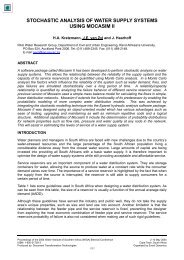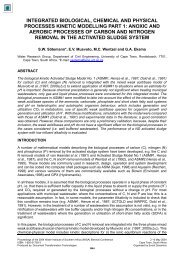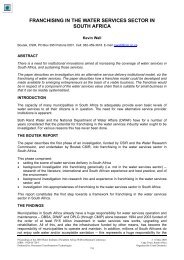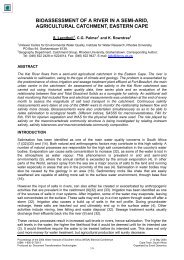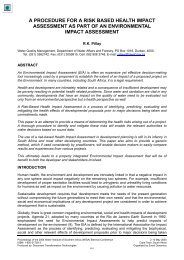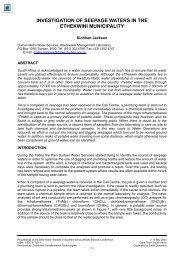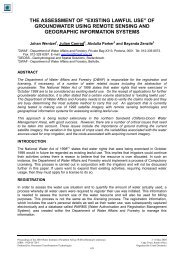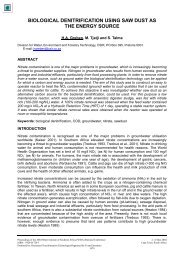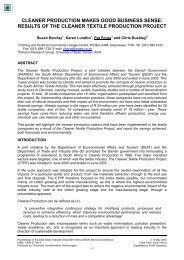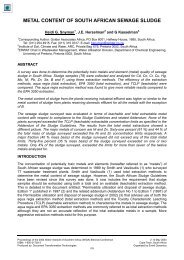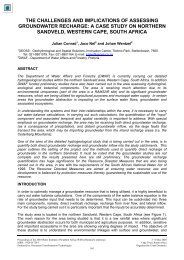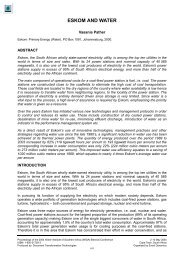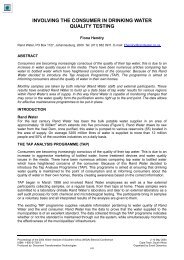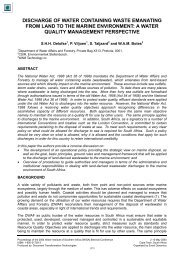Integrated Pond and BNR Activated Sludge Treatment ... - eWISA
Integrated Pond and BNR Activated Sludge Treatment ... - eWISA
Integrated Pond and BNR Activated Sludge Treatment ... - eWISA
You also want an ePaper? Increase the reach of your titles
YUMPU automatically turns print PDFs into web optimized ePapers that Google loves.
INTEGRATED POND AND <strong>BNR</strong> ACTIVATED SLUDGE<br />
TREATMENT PROCESS TO ACHIEVE RELIABLE<br />
NITROGEN AND PHOSPHORUS REMOVAL<br />
Annalien Toerien<br />
Golder Associates Africa, PO Box 6001, Halfway House, 1685. E-mail: atoerien@golder.co.za<br />
ABSTRACT<br />
Advanced wastewater treatment for smaller communities can be achieved without expensive plant<br />
upgrades. Existing pond treatment systems can be integrated successfully with Biological Nutrient<br />
Removal <strong>Activated</strong> <strong>Sludge</strong> <strong>Treatment</strong> technology. The combination of anaerobic ponds <strong>and</strong><br />
activated sludge can be implemented in a series or parallel configuration, with existing oxidation<br />
ponds as a side stream treatment process or converted to Polishing Wetl<strong>and</strong>s. The key process<br />
consideration is maintenance of a favourable COD:N ratio for effective nutrient removal in the<br />
activated sludge process.<br />
INTRODUCTION<br />
In many catchments stricter discharge st<strong>and</strong>ards are being introduced, based on:<br />
• the sensitivity of the catchments <strong>and</strong> downstream users<br />
• the receiving water quality limitations in already impacted river reaches <strong>and</strong> impoundments<br />
• the access to improved technology <strong>and</strong> finance to enable the treatment of effluent to higher<br />
st<strong>and</strong>ards compared to past practices<br />
• an increase in public awareness <strong>and</strong> regulatory pressure regarding the environmental<br />
protection.<br />
Due to increased urbanisation <strong>and</strong> developments with associated housing <strong>and</strong> the introduction of<br />
waterborne sanitation, sewage flows have increased substantially in many towns <strong>and</strong> cities.<br />
Pressure on the available l<strong>and</strong> <strong>and</strong> resources has also increased. The consequence is that space<br />
is constrained in some areas <strong>and</strong> large pond systems treatment facilities may not be viable<br />
anymore. With increased pressure for effective nutrient removal, processes that can do so<br />
naturally, rather than chemically, is favoured.<br />
The challenge is to incorporate existing pond infrastructure with new <strong>and</strong> advanced technology in<br />
order to:<br />
• minimize capital investment <strong>and</strong> operational costs<br />
• reliably treat effluent to achieve the effluent discharge st<strong>and</strong>ards applicable – especially N <strong>and</strong><br />
P removal<br />
• minimize the impact on l<strong>and</strong> availability, surrounding communities <strong>and</strong> downstream users<br />
BACKGROUND<br />
<strong>Pond</strong> systems are mainly used for the treatment of domestic wastewater from smaller<br />
communities, where the main focus is the removal of COD <strong>and</strong> TSS. Very often, the ratio of<br />
nutrients in the wastewater is predominantly COD <strong>and</strong> nitrogen, due to the concentrated nature of<br />
the effluent.<br />
Anaerobic ponds are effective in the removal of carbon, while facultative <strong>and</strong> oxidation ponds<br />
provide some polishing treatment to decrease nutrients but performance is sometimes poor,<br />
especially in winter. Nitrogen (N) is more effectively removed than phosphorus (P). The nutrient<br />
ratio in pond effluent is therefore changed to low carbon (COD) <strong>and</strong> an imbalance between N <strong>and</strong><br />
Proceedings of the 2004 Water Institute of Southern Africa (WISA) Biennial Conference 2 –6 May 2004<br />
ISBN: 1-920-01728-3 Cape Town, South Africa<br />
Produced by: Document Transformation Technologies Organised by Event Dynamics
P, should further nutrient removal be required.<br />
<strong>BNR</strong> (biological nutrient removal) systems are activated sludge systems that create conditions that<br />
enable the utilization <strong>and</strong> therefore removal of not only carbon, but also nitrogen <strong>and</strong> phosphorus.<br />
The ratio between COD : N : P are required in a relatively narrow b<strong>and</strong> to enable the biochemical<br />
reactions to sustain the utilization <strong>and</strong> removal of both nutrients (NSP) within the required ranges.<br />
To achieve this, pond systems <strong>and</strong> <strong>BNR</strong> activated sludge treatment processes can be combined<br />
successfully.<br />
PROCESS CONFIGURATION<br />
The integration of ponds <strong>and</strong> <strong>BNR</strong> activated sludge can be either in series or in a parallel process<br />
configuration. Two possible combinations are discussed in more detail.<br />
Raw Sewage<br />
Mechanical<br />
Screening<br />
Oxidation <strong>Pond</strong>s<br />
Vortex<br />
Degritters Measuring<br />
Flume<br />
Anaerobic <strong>Pond</strong>s<br />
Primary<br />
Clarifiers<br />
Dry <strong>Sludge</strong><br />
Belt Press<br />
<strong>Activated</strong> <strong>Sludge</strong><br />
Anaerobic<br />
Digestion<br />
<strong>Sludge</strong><br />
Fermentation<br />
Secondary<br />
Clarification<br />
Figure 1. Series configuration of integrated ponds <strong>and</strong> <strong>BNR</strong> processes.<br />
WAS<br />
Thickeners<br />
Chlorine<br />
Disinfection<br />
Series Configuration<br />
This configuration consists of the following (refer to Figure 1):<br />
• Preliminary treatment – screening, degritting <strong>and</strong> flow measurement;<br />
• Primary treatment – primary clarification, with sludge fermentation for the production of volatile<br />
fatty acids (VFA) <strong>and</strong> anaerobic pond treatment of the primary effluent <strong>and</strong> primary sludge.<br />
Oxidation pond effluent is returned to the anaerobic ponds <strong>and</strong> utilised as an oxygen-rich<br />
surface water layer for odour control.<br />
• Secondary treatment – <strong>BNR</strong> activated sludge treatment with secondary clarification, sludge<br />
return <strong>and</strong> final disinfection.<br />
• <strong>Sludge</strong> treatment – anaerobic or aerobic sludge digestion <strong>and</strong> dewatering on either drying beds<br />
or by mechanical means.
This configuration maximises the availability of readily biodegradable carbon in the anaerobic zone<br />
for the uptake of Phosphorus. Nitrification <strong>and</strong> denitrification, as well as final carbon polishing is<br />
subsequently achieved in the <strong>BNR</strong> reactor. The process configuration is a variation of the<br />
well-known PETRO TM process, <strong>and</strong> has been successfully applied.<br />
Parallel Configuration<br />
The parallel configuration of ponds <strong>and</strong> the <strong>BNR</strong> activated sludge process, consists of the following<br />
process components (refer to Figure 2):<br />
• preliminary treatment – screening, degritting <strong>and</strong> flow measurement;<br />
• the raw sewage feed stream is divided between the ponds <strong>and</strong> <strong>BNR</strong> reactor in parallel, to<br />
provide a high carbon feed stream directly to the activated sludge process. This enhances the<br />
enhanced biological P-removal;<br />
• anaerobic pond treatment, including primary sludge digestion of the raw sewage;<br />
• with sufficient reduction of the COD in the ponds, a nitrification trickling filter can be<br />
incorporated on a recycle stream to modify the COD : N ratio <strong>and</strong> to improve overall nitrogen<br />
removal. The recycle stream will also provide a NO3 -N rich surface water layer for odour<br />
control;<br />
• activated sludge treatment – <strong>BNR</strong> activated sludge treatment with secondary clarification,<br />
sludge return <strong>and</strong> final disinfection. The feed to the activated sludge process is a combination<br />
of the treated pond effluent <strong>and</strong> the high carbon, raw sewage feed;<br />
• sludge treatment – anaerobic or aerobic digestion <strong>and</strong> dewatering.<br />
Raw<br />
Wastewater<br />
A<br />
Bar<br />
Screen<br />
Preliminary <strong>Treatment</strong><br />
Manual<br />
Screening<br />
<strong>Activated</strong> <strong>Sludge</strong> Reactor<br />
<strong>Activated</strong> <strong>Sludge</strong> Reactor<br />
Nitrification<br />
Towers<br />
Grit<br />
Removal<br />
RAS Pumps<br />
Parallel <strong>Integrated</strong> <strong>Pond</strong>s / <strong>BNR</strong> <strong>Activated</strong> <strong>Sludge</strong> Process<br />
BENEFITS<br />
Bioclarifier<br />
Bioclarifier<br />
Anaerobic <strong>Pond</strong>s<br />
Anaerobic <strong>Pond</strong>s<br />
Aerobic<br />
Digestion<br />
<strong>Sludge</strong><br />
<strong>Sludge</strong><br />
Chlorine Disinfection<br />
<strong>Sludge</strong><br />
Drying Beds<br />
Figure 2. Parallel configuration of integrated ponds <strong>and</strong> <strong>BNR</strong> processes<br />
The benefits of integrating ponds <strong>and</strong> <strong>BNR</strong> activated sludge processes are:<br />
AP<br />
Recycle<br />
Pumps<br />
Polishing<br />
Wetl<strong>and</strong>s<br />
9101-A9<br />
Plant<br />
Effluent<br />
A
• smaller sized activated sludge reactors due to the lower COD load feed to the <strong>BNR</strong> process.<br />
The bulk of reactor tankage is typically required for carbon removal. This can be reduced<br />
substantially with pre-treating the wastewater in anaerobic ponds;<br />
• improved COD : N : P ratios optimise the overall performance of the treatment process;<br />
• multiple barriers are put in place to provide at least partial treatment of the wastewater before<br />
discharge, should any individual treatment component experience an upset condition;<br />
• existing infrastructure is integrated with modern technology to improve treatment <strong>and</strong> to<br />
successfully achieve strict Nitrogen <strong>and</strong> Phosphorus discharge st<strong>and</strong>ards;<br />
• some of the redundant oxidation ponds on existing treatment plants can be retrofitted as<br />
wetl<strong>and</strong>s to provide final polishing of the treated effluent. This also provides an additional<br />
barrier to protect against breakthroughs in the event of process or plant upsets;<br />
• stormflow attenuation can be done by utilising some of the ponds for this purpose. This will<br />
protect the downstream processes against excessive hydraulic loads that may wash the<br />
biomass out.<br />
CHALLENGES<br />
<strong>Pond</strong>s exhibit variable performance due to seasonal variations in temperature <strong>and</strong> solar radiation,<br />
with the consequent drop in performance. <strong>Treatment</strong> plants should therefore be designed with<br />
sufficient flexibility to enable adjustments to be made to improve the effluent quality. Variability in<br />
feed to either the <strong>BNR</strong> process or anaerobic ponds can be done by controlling the percentage feed<br />
to either of the two processes. The entry point of the treated anaerobic pond effluent into the <strong>BNR</strong><br />
process can also be adjusted to any of the zones.<br />
PRACTICAL APPLICATIONS AND TARGETS<br />
The concept of integrated pond <strong>and</strong> <strong>BNR</strong> activated sludge treatment processes have been<br />
implemented at a number of wastewater treatment plants now under construction <strong>and</strong> some in<br />
operation.<br />
Wastewater treatment plants under planning <strong>and</strong> construction include the following:<br />
• Mothutlung - Madibeng Municipality (2.4 Ml/d)<br />
• Mahwereleng - Mogalakwena Municipality (5.8 Ml/d)<br />
Wastewater treatment plants in operation include those at:<br />
• Emthonjeni – Highveld District Council (1.5 Ml/d) Parallel configuration<br />
• Rietgat – Tshwane Metropolitan Council (27.5 Ml/d capacity) Series configuration<br />
Raw Wastewater Quality<br />
Parameter<br />
Table 1. Raw wastewater quality data.<br />
50 percentile 95 percentile<br />
Alkalinity (mg CaCO3/l) 229 350<br />
TSS (mg/l) 325 565<br />
TKN (mg N/l) 46 167<br />
Ammonia (mg N/l) 22.8 88<br />
COD (mg COD/l) 821 1508<br />
TP (mg P/l) 10.5 23.6<br />
PO4 (mg P/l) 8.7 21.3
Typical domestic wastewater quality treatment in integrated <strong>Pond</strong>-<strong>BNR</strong> activated sludge processes<br />
are summarised in Table 1.<br />
The typical final treated effluent quality from integrated <strong>Pond</strong>-<strong>BNR</strong> activated sludge processes is<br />
summarised in Table 2.<br />
Table 2: Final effluent quality data.<br />
Treated wastewater Quality Parameter Based on the 50 percentile conditions<br />
TSS (mg/l) < 20<br />
Nitrate (mg N/l) < 8<br />
Ammonia (mg N/l) < 3<br />
COD (mg COD/l) < 60<br />
PO4 (mg P/l) < 1<br />
CONCLUSIONS<br />
The conclusions of the full scale integration of ponds <strong>and</strong> <strong>BNR</strong> activated sludge processes are as<br />
follows:<br />
• it is not necessary to ab<strong>and</strong>on ponds when upgrading a plant to achieve strict N <strong>and</strong> P<br />
st<strong>and</strong>ards, in fact to ab<strong>and</strong>on existing ponds in favour of “modern” technology may be a<br />
wasteful use of available infrastructure<br />
• treatment of wastewater in ponds will modify the desirable COD : N : P ratio for biological<br />
nutrient removal. This can be rectified by a number of process refinements including:<br />
- side stream flow of high carbon (COD) containing streams directly to the <strong>BNR</strong> activated<br />
sludge treatment process<br />
- optimised Nitrogen removal in the pond system by incorporation of nitrification trickling<br />
filters on a recycle stream<br />
• seasonal adjustment to the integrated pond <strong>and</strong> <strong>BNR</strong> activated sludge system may be required<br />
to account for the variable performance of pond treatment systems.



